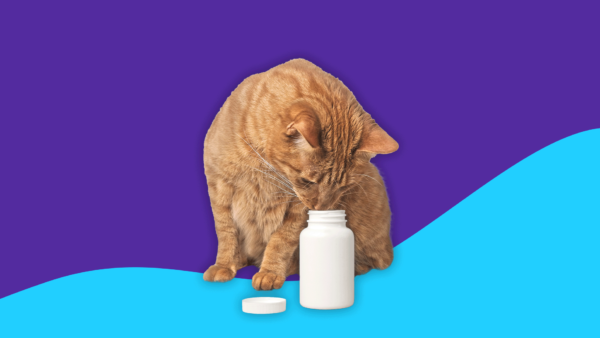When your furry friends are unwell, helping them feel better as quickly and painlessly as possible is every pet owner’s goal. Sometimes, that might mean giving them pet antibiotics. But how do pet antibiotics work and what do you need to look out for? Read on.
What are pet antibiotics?
Pet antibiotics are medications that may be prescribed by a veterinarian when your dog or cat has a bacterial infection—like an ear infection, urinary tract infection, or skin infection. They can also be used to prevent infections from setting in during a high-risk situation, like after a large wound or during abdominal surgery. But don’t run to the medicine cabinet just yet. Like with humans, using an antibiotic on a virus is ineffective.
“Before you can decide if antibiotics are necessary, it’s important to understand whether there’s a bacterial component to the infection at all,” says Georgina Ushi Phillips, DVM, a veterinarian based in West Chapel, Florida.
“While that can sound obvious, conditions like upper respiratory infections may have bacterial or viral components—and, in many cases, a combination of both,” Dr. Phillips explains. “If the infection is only viral, not only are antibiotics not warranted, but they can actually contribute to antibiotic resistance among certain types of bacteria.”
If your veterinarian determines that an antibiotic would be effective, the next step is to determine what pet antibiotic is most effective, since most antibiotics don’t treat specific conditions, but rather types of bacteria.
“To ensure veterinarians are good stewards of antibiotics and prevent resistance, I recommend either culturing or using appropriate first-line medication,” says Michelle Burch, DVM, a veterinarian based in Decatur, Alabama.
“Culturing an area of infection will determine the exact species of bacteria then determine the appropriate antibiotic to eliminate the infection,” Dr. Burch says. “Culturing helps to determine if the bacteria is resistant to certain medications or has a low sensitivity, which can increase the risk of resistance.”
Can pets take human antibiotics?
Although antibiotics will work to fight bacteria, whether it’s used on a human or animal, it’s important to not give antibiotics prescribed to people, says Dr. Phillips. Some antibiotics work better in some species over others and dosages may be different. Side effects can also vary greatly between species.
Even in classes of medicine that are prescribed to both humans and animals, certain medicines may be toxic for pets due to differences in metabolism between people and dogs or cats. Veterinarian oversight is critical to making sure the right antibiotics are used on pets.
For example, Dr. Phillips said, “Amoxicillin-clavulanic acid is a commonly used antibiotic in both pets and people under several brand names. But the ratio of amoxicillin to clavulanic acid varies significantly between products that are intended for humans and those that are intended for pets. These kinds of differences can make a big impact on the effectiveness of the antibiotic.”
Bottom line: if you think your dog or cat may need pet antibiotics, it’s best to see a vet and get a prescription to keep your pet safe and get them healthy once again. In some cases, your vet may send you to a human pharmacy to pick up the medication. In others, your pet will need a specially formulated Rx.
RELATED: Can I save on medication for my pets?
What are the most common dog antibiotics?
If your dog needs an antibiotic, it’s likely to be one of the pet antibiotics below, said Dr. Phillips.
- Amoxil (amoxicillin): This broad-spectrum antibiotic can treat many different types of bacterial infections in dogs from respiratory issues to gastrointestinal problems.
- Clavamox (amoxicillin-clavulanic acid): Commonly used to treat wounds, urinary tract infections, and some respiratory infections
- Flagyl (metronidazole): Used to treat infections of the digestive system and anaerobic infections, metronidazole can also treat several intestinal parasites as well
- Cleocin (clindamycin): Most often used to treat infections related to teeth and bones
- Baytril (enrofloxacin): Baytril is used for a wide range of infections including those related to the respiratory system, blood infections, or infection secondary to abdominal surgery
- Garamycin (gentamicin): This medication treats eye, ear, and lung infections in dogs. It is also commonly in topical preparations for skin infections.
- Bactrim (sulfamethoxazole-trimethoprim): Used to treat urinary tract infections, it can sometimes cause stomach problems for dogs. Giving antibiotics with food can help to reduce this side effect.
- Vibramycin (doxycycline): Can be used in dogs to treat Ehrlichia, which is a tick-borne disease, lower airway disease, and heartworm disease
- Keflex (cephalexin) varies by form: Broad-spectrum antibiotic that’s most often used to treat skin infections
What are the most common cat antibiotics?
If your cat needs an antibiotic, there are some of the most commonly prescribed.
- Amoxil (amoxicillin): This broad-spectrum antibiotic can treat many different types of bacterial infections from ear infections and urinary tract infections to respiratory issues.
- Flagyl (metronidazole): Used to treat infections of the digestive system and anaerobic infections, metronidazole can also treat several intestinal parasites as well
- Cleocin (clindamycin): Most often used to treat infections related to teeth and bones
- Garamycin (gentamicin): Available as an injectable or topical medication for cats, it can treat infected wounds or ear infections
- Keflex (cephalexin) varies by form: Broad-spectrum antibiotic that’s most often used to treat skin infections
- Baytril (enrofloxacin): Baytril is used for a wide range of infections including those related to the respiratory system, blood infections, or infection secondary to abdominal surgery
- Vibramycin (doxycycline): Used to treat respiratory infection in cats.
What to do if your pet needs antibiotics
Before giving antibiotics to your pet, it’s best to first consult with a vet who understands your pet’s medical history to ensure there are minimal side effects and no interactions with any other medications.
Once you have a prescription, you can usually pick it up at a pet store or your local pharmacy—be sure they don’t stray from the original prescription in any way unless they’ve consulted with the vet. (And, yes, if you pick up from a human pharmacy, you can use a SingleCare coupon to save!) Some medications may have side effects like low appetite, vomiting, and diarrhea. If your dog or cat exhibits any of these symptoms, it’s a good idea to contact your vet.
Most importantly, it’s critical that you administer the entire course of antibiotics, even if your pet improves and the infection looks like it’s resolved. Because animals usually aren’t eager to take medication and it can be tough on their owners, people sometimes stop pet antibiotics early, leaving your pet at risk for becoming unwell again. Stay the course and your pet’s health will thank you.











